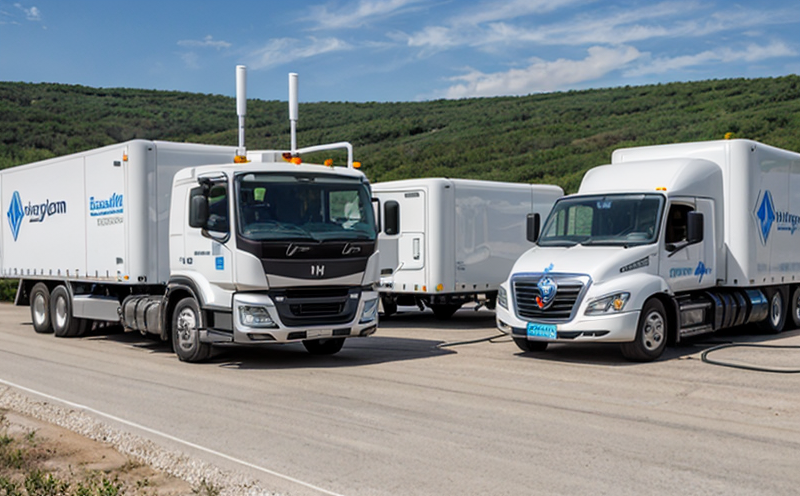ASTM E1742 Radiographic Testing of Hydrogen Tanks
The ASTM E1742 standard is a critical process in the quality assurance framework for hydrogen tanks. This radiographic testing method is essential because it provides non-destructive evaluation (NDE) that ensures the structural integrity of these vital components. Hydrogen tanks are not only crucial for storing hydrogen gas, which is used in various energy sectors like fuel cells and hydrogen-powered vehicles, but they must also meet stringent safety requirements to prevent leaks or failures.
The testing process involves exposing a specimen to penetrating radiation (typically X-rays), capturing an image on film or digital media, and analyzing the resultant radiographic image for defects. The primary goal is to identify any flaws such as cracks, porosity, or inclusions that could compromise safety or performance. This service ensures compliance with international standards like ISO 17635, which mandates specific quality assurance practices for radiography.
The ASTM E1742 standard specifies the use of industrial radiographic techniques to inspect metallic materials, including hydrogen tanks made from stainless steel, aluminum, and other alloys. The testing method is particularly useful in detecting internal defects that cannot be easily identified by visual inspection alone. It provides a detailed examination that helps manufacturers and operators maintain high standards of safety.
For quality managers and compliance officers, this service ensures that the hydrogen tanks meet all necessary regulatory requirements. In addition to ASTM E1742, other relevant standards include ISO 9712 for NDE personnel qualifications, which is crucial for ensuring that only qualified personnel perform these tests. The testing process involves meticulous specimen preparation, including cleaning and degreasing of the tank surface to ensure accurate imaging.
The radiographic images are captured using advanced equipment, such as digital radiography (DR) systems or computed tomography (CT) machines, which provide high-resolution images for detailed analysis. The resulting images are evaluated by experienced technicians who follow strict criteria outlined in ASTM E1742 to determine the presence and size of any defects. This process ensures that only safe and reliable hydrogen tanks enter the market.
The importance of this service cannot be overstated, especially given the increasing demand for hydrogen as a clean energy solution. Hydrogen-powered vehicles are expected to play a significant role in reducing carbon emissions, but their widespread adoption depends on the reliability and safety of the fueling infrastructure. ASTM E1742 radiographic testing is an integral part of this effort, ensuring that each hydrogen tank meets the highest quality standards.
For R&D engineers, this service provides valuable insights into material properties and potential design flaws, enabling continuous improvement in hydrogen tank technology. The testing process also helps procurement teams source materials and components from reliable suppliers who adhere to these stringent quality control measures.
Why It Matters
The ASTM E1742 radiographic testing of hydrogen tanks is essential for ensuring the safety, reliability, and compliance with international standards. Hydrogen tanks are critical components in the hydrogen energy ecosystem, playing a vital role in storing and delivering hydrogen gas to various applications, including fuel cells, hydrogen vehicles, and industrial processes.
The integrity of these tanks directly impacts public safety and environmental sustainability. A single failure can lead to significant operational disruptions, property damage, or even loss of life. By adhering to ASTM E1742 standards, manufacturers can ensure that their hydrogen tanks are free from defects that could compromise their structural integrity.
Compliance with these standards is not just a legal requirement but also a commitment to excellence in quality and safety. The testing process helps identify potential flaws early in the manufacturing or maintenance cycle, allowing for timely corrective actions before they become critical issues. This proactive approach enhances overall operational efficiency and reduces downtime associated with unexpected failures.
For R&D engineers and procurement professionals, ASTM E1742 radiographic testing provides invaluable data that can be used to improve product design and sourcing practices. The detailed insights gained from this process help in identifying areas for innovation while ensuring consistency across production batches. For quality managers and compliance officers, it ensures regulatory adherence and builds trust with stakeholders.
In summary, ASTM E1742 radiographic testing is a cornerstone of the hydrogen tank manufacturing industry. It guarantees that each component meets the highest standards of safety and reliability, contributing to a more sustainable future for hydrogen energy applications.
Applied Standards
| Standard | Description |
|---|---|
| ASTM E1742 | Specifies the use of industrial radiographic techniques for inspecting metallic materials, including hydrogen tanks. |
| ISO 9712 | Mandates specific quality assurance practices for radiography personnel. |
| EN 444 | Lays out the requirements for non-destructive testing methods, including radiographic examination. |
| American Society of Mechanical Engineers (ASME) Section VIII Division 1 | Provides guidelines for pressure vessel design and fabrication, which includes hydrogen tanks. |
| International Organization for Standardization (ISO) 9001 | Ensures that the testing process adheres to quality management systems. |
| Standard | Description |
|---|---|
| American Society for Testing and Materials (ASTM) E1826 | Defines the requirements for radiographic film processing. |
| International Electrotechnical Commission (IEC) 60854-1 | Covers the performance specifications of digital radiography systems. |
| American Society for Testing and Materials (ASTM) E744 | Outlines the requirements for computed tomography in materials testing. |
| European Committee for Standardization (CEN) EN 45018 | Establishes the guidelines for the qualification of non-destructive testing personnel. |
Competitive Advantage and Market Impact
- Maintains compliance with international standards, ensuring regulatory adherence.
- Demonstrates a commitment to quality and safety, building trust among stakeholders.
- Provides detailed insights into material properties and potential design flaws for R&D engineers.
- Helps procurement teams source materials from reliable suppliers who adhere to high-quality control measures.
- Ensures timely corrective actions before critical issues arise, enhancing operational efficiency and reducing downtime.
- Supports the transition towards a more sustainable hydrogen energy ecosystem by ensuring reliability and safety of components.





